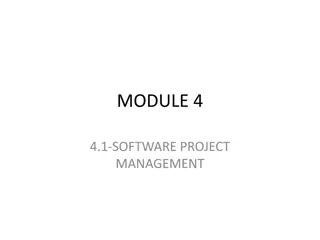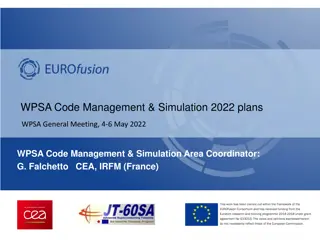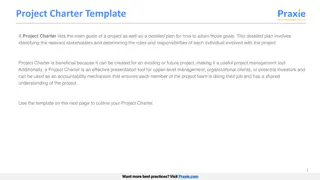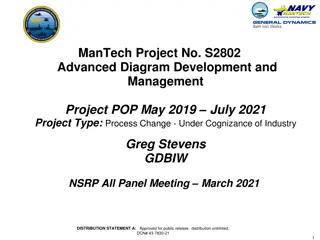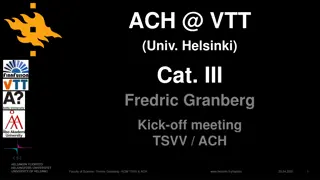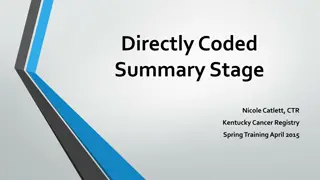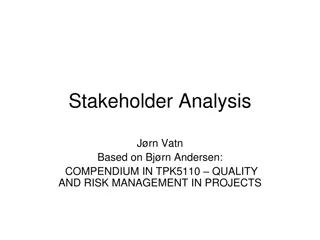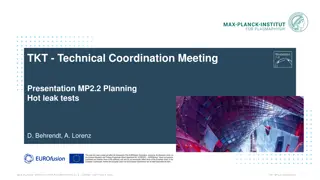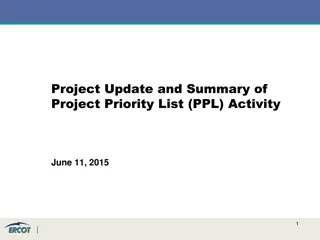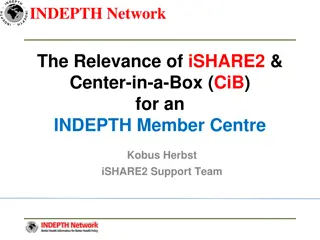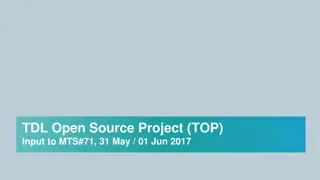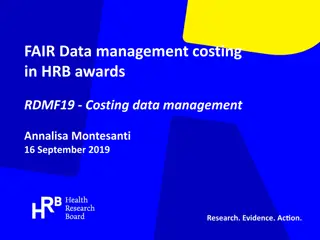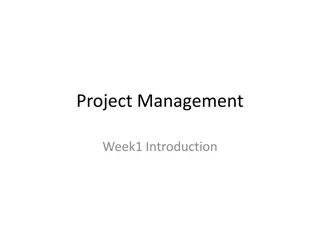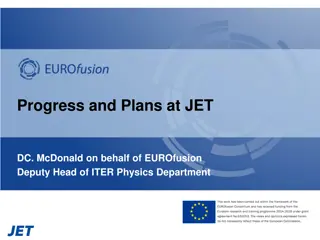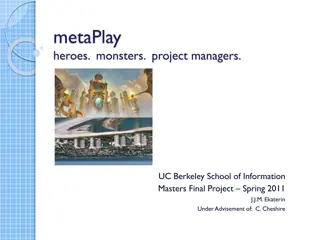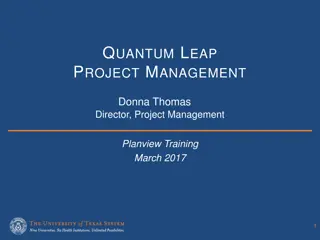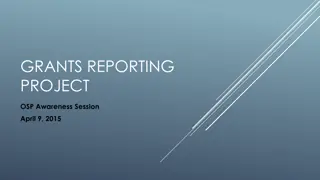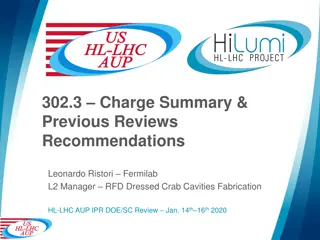EUROfusion Data Management Project Summary
EUROfusion data management project led by P. Strand at Chalmers outlines a comprehensive data management plan with four scenarios of increasing ambition, from making metadata available to open access for non-embargoed data. The plan includes strategies for interoperability, data accessibility, enhanced provenance, referencing, and open data access. Implementation involves building a portal interface on the Gateway supported by a core team, integrated documentation, software, and ticketing services, and proposed initial sites for requirements driven by user applications in fusion research.
Download Presentation

Please find below an Image/Link to download the presentation.
The content on the website is provided AS IS for your information and personal use only. It may not be sold, licensed, or shared on other websites without obtaining consent from the author.If you encounter any issues during the download, it is possible that the publisher has removed the file from their server.
You are allowed to download the files provided on this website for personal or commercial use, subject to the condition that they are used lawfully. All files are the property of their respective owners.
The content on the website is provided AS IS for your information and personal use only. It may not be sold, licensed, or shared on other websites without obtaining consent from the author.
E N D
Presentation Transcript
Summary of the EUROfusion data management project P r Strand, Chalmers, for EUROfusion and DMP SiCo team EF-IO coordination meeting| 2023-10-10
EUROfusion Data management Plan The data management plan defines 4 scenarios of increasing ambition Scenario A: making metadata only available and searchable using IMAS data subsets for interoperable definitions of quantities [F,(I)]. Scenario B: adds to Scenario A by allowing a subset of the data to be accessed using common tools (for example UDA). Facilities are responsible for the access level and qualification of data through the data mappings [F,A,I,(R)]. Scenario C: builds on the previous stages and allows for enhanced data provenance and referencing through PID s [F,A,I,R]. Scenario D: adds a lightweight layer for open access to non-embargoed metadata and where allowed by the facilities also data access for export in human readable formats (CSV files) [F,A,I,R] and open.
EUROfusion Data management Plan The data management plan defines 4 scenarios of increasing ambition Scenario A: making metadata only available and searchable using IMAS data subsets for interoperable definitions of quantities [F,(I)]. Implement! Scenario B: adds to Scenario A by allowing a subset of the data to be accessed using common tools (for example UDA). Facilities are responsible for the access level and qualification of data through the data mappings [F,A,I,(R)]. )]. Prototype! Start implement! Scenario C: builds on the previous stages and allows for enhanced data provenance and referencing through PID s [F,A,I,R]. Defer. Resource restricted but important! Scenario D: adds a lightweight layer for open access to non-embargoed metadata and where allowed by the facilities also data access for export in human readable formats (CSV files) [F,A,I,R] and open. Defer.
Implementation The portal interface and development activities will be hosted on the Gateway Supported by a Core team for the central services Documentation, software and ticketing will be integrated with the existing PSNC based gitlab and jira services. The Infrastructure will be built on the Fair for Fusion provided software tools and developed practices, e.g., Blueprint architecture Initial sites are proposed to consist of AUG, JET, MAST-U, TCV and WEST Requirements driven by user and in particular user applications TSVV/ENR and other FSD/FTD projects
Central services Core Facilities Prototyping Portal Helpdesk Deployment and Hardening Maintenance Ticketing system User Support UDA support Production use Portal extensions Exp. profiles 2024- Focus 2023 - Enhancements
Core Services - for the users Users (researchers) will mostly focus on the search engine and user interface Metadata access, next step allow for downloading of a subset of experimental data in IMAS format Give it a try and tell us what you think! DMP Feedback Google Form https://scilla.man.poznan.pl/dashboard/
Core Services Current development is focused on Developing the User Interface and improving User Experience Delivering improved performance (highly responsive application) Looking at optimization of data retrieval/collection Next stage work providing unified and simplified access to experimental data Technology underpinnings: Authentication and Authorization Infrastructure new data sources for Catalog QT 2 (e.g. HDF5 / CSV / simDB) developments related to `UDA` - e.g. Docker based server / client General approach delivering software based on state of the art software development practices: Unit Tests, Integration Tests, automatic delivery of all the components (CI/CD, test releases, nightly builds)
Core Services - for the data owners Data owners can benefit from Docker based `UDA` solution - client / server https://gitlab.eufus.psnc.pl/containerization/imas/imas-installer/- /tree/main#uda
Site activities Sites Data Access Services Data Mappnings Workflow Prototyping Scenario B Integration (push data to portal) UDA support (data access, workflow) IMAS Infrastructure Metadata DB - AAI necessary - UDA call from portal - Local to users (No secondary storage of exp data) Extended data mappings Scenario A Push data (automagic) Static uploads test data Available AAI integration Installation and testing To be developed 2024? Data mappings continous activity growing based on users needs (applications driven) (CCFE tool + JSON mapping file, ) Extensions 2023/24 Autumn 2023
Site Services Discussions with AUG,WEST, TCV, MAST-U, JET, (W-7X), COMPASS-Upgrade. (ongoing) Restarted due to reformulation of the scenario B implementation Bespoke tools to provide static metadata CSV or similar for use in portal/dashboard testing. (available/data extensions needed) Aim is to allow for automatic updates pushed from the data providers (development work 2023/24) May be supported by UDA installations Installation and testing of IMAS/UDA installations on each site (started on most sites) Mapping existing tools and knowledge to project needs - join forces with ITER work on experimental data mappings? (not yet or barely started) Discussions with users /code owners/developers and the TSVV projects to define scope of data mappings. (to be started this fall but input available for some stakeholders already) Important external dependency AAI to secure that access is properly authorized. (started but implementation pace is not clear for all parties).
Status and reflections - discussion points? Status: DMP scenario A on path, scenario B reformulated with new resource allocations. Concerns on integration with modelling/simulation data! LTSSF? Reflections (collected from stakeholders and others ) Disruptive update for DD4/AL5 (non backwards compatible changes - fundamental change of geometry description) Experiments: wait to push experimental mappings until fully available? Customer side delays anticipated - rewrite of code base, revalidation, revisit already done IMASification work! IMASification already slow and questioned! In general: mature enough infrastructure to invest in? Fit for purpose? Governance and steering! BUT, probably the way to go. Muddled responsibilities/task separation ACH/TSVV vs ITER contractors Risk for overlap and duplication? What interfaces to use for charges?



